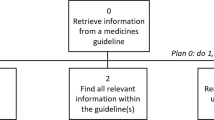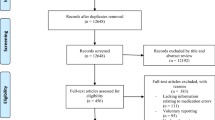Abstract
Background: Tenfold errors in calculation of paediatric drug doses are often life threatening. The magnitude and characteristics of this phenomenon have not been fully described.
Objectives: The objective of this study was to describe the incidence and nature of paediatric tenfold errors and to describe the effect of different detection approaches on the detection of such errors.
Methods: To evaluate the incidence of tenfold errors, data were collected from three different studies on medication errors all conducted at a large tertiary care paediatric hospital: (i) a study investigating medication event reports to the hospital’s Medication Incident Committee; (ii) a study auditing the charts of 1532 patients in the emergency department (ED) and; (iii) a prospective study of medication errors occurring during mock code resuscitations in the ED.
Results: In the first study, 20 tenfold errors were reported during the surveyed period. Almost all errors were prescribing errors. The calculated incidence was 1 per 22 500 doses prescribed. In chart auditing study in the ED, two tenfold errors where found in 1678 orders. In the prospective study, four tenfold errors were identified in eight mock resuscitations (125 orders for drugs).
Conclusion: The incidence of tenfold errors in paediatrics varies dramatically when different detection approaches are used. The rate of tenfold errors may be especially high in resuscitation situations and is underestimated by spontaneous reporting.

Similar content being viewed by others
References
Leape LL, Brennan TA, Laird N, et al. The nature of adverse events in hospitalized patients: results of the Harvard Medical Practice Study II. N Engl J Med 1991; 324(6): 377–84
Bates DW, Cullen DJ, Laird N, et al. Incidence of adverse drug events and potential adverse drug events: implications for prevention. ADE Prevention Study Group. JAMA 1995; 274(1): 29–34
Kohn LT, Corrigan JM, Donaldson MS. To err is human: building a safer health system. Washington, DC: National Academy Press, 2000
Ross LM, Wallace J, Paton JY. Medication errors in a paediatric teaching hospital in the UK: five years operational experience. Arch Dis Child 2000; 83(6): 492–7
Wakefield BJ, Wakefield DS, Uden-Holman T. Improving medication administration error reporting systems: why do errors occur? Ambul Outreach 2000; Spring: 16–20
Lesar TS, Lomaestro BM, Pohl H. Medication-prescribing errors in a teaching hospital: a 9-year experience. Arch Intern Med 1997; 157(14): 1569–76
Lesar TS. Errors in the use of medication dosage equations. Arch Pediatr Adolesc Med 1998; 152(4): 340–4
Koren G, Barzilay Z, Greenwald M. Tenfold errors in administration of drug doses: a neglected iatrogenic disease in pediatrics. Pediatrics 1986; 77(6): 848–9
Rowe C, Koren T, Koren G. Errors by paediatric residents in calculating drug doses. Arch Dis Child 1998; 79(1): 56–8
Gmur J, Bischof B, Coninx S, et al. Spontaneous hematologic recovery from bone marrow aplasia after accidental tenfold overdosage with radiophosphorus. Blood 1983; 61(4): 746–50
Goebel J, Ananth M, Lewy JE. Hemodiafiltration for vancomycin overdose in a neonate with end-stage renal failure. Pediatr Nephrol 1999; 13(5): 423–5
Kozer E, Scolnik D, Keays T, et al. Large errors in the dosing of medications for children. N Engl J Med 2002; 346(15): 1175–6
Kozer E, Scolnik D, Macpherson A, et al. Variables associated with medication errors in pediatric emergency medicine. Pediatrics 2002; 110(4): 737–42
Kozer E, Seto W, Verjee Z, et al. Prospective observational study on the incidence of medication errors during simulated resuscitation in a paediatric emergency department. BMJ 2004; 329(7478): 1321
Flynn EA, Barker KN, Pepper GA, et al. Comparison of methods for detecting medication errors in 36 hospitals and skilled-nursing facilities. Am J Health Syst Pharm 2002; 59: 436–46
Morimoto T, Gandhi TK, Seger AC, et al. Adverse drug events and medication errors: detection and classification methods. Qual Saf Health Care 2004; 13: 306–14
Lesar TS. Tenfold medication dose prescribing errors. Ann Pharmacother 2002; 36(12): 1833–9
Cullen DJ, Bates DW, Small SD, et al. The incident reporting system does not detect adverse drug events: a problem for quality improvement. Jt Comm J Qual Improv 1995; 21(10): 541–8
Barach P, Small SD. Reporting and preventing medical mishaps: lessons from non-medical near miss reporting systems. BMJ 2000; 320(7237): 759–63
Ferner RE. Is there a cure for drug errors? BMJ 1995; 311(7003): 463–4
Acknowledgements
The authors have no conflicts of interest that are directly relevant to the content of this study. Eran Kozer is a recipient of a fellowship grant from the Research Training Centre, the Hospital for Sick Children. Gideon Koren is holder of the Ivey Chair in Molecular Toxicology, The University of Western Ontario.
This paper has been presented in part at the following meetings: the Annual Meeting of the American Society for Clinical Pharmacology and Therapeutics (Atlanta, Georgia, USA, 24–27 March, 2002) and; the Pediatric Academic Societies Meeting (Baltimore, Maryland, USA, 4–7 May 2002).
Author information
Authors and Affiliations
Corresponding author
Additional information
Pediatric Emergency Services, Assaf Harofeh Medical Center, Zerifin 70300, Israel.
Rights and permissions
About this article
Cite this article
Kozer, E., Scolnik, D., Jarvis, A.D. et al. The Effect of Detection Approaches on the Reported Incidence of Tenfold Errors. Drug-Safety 29, 169–174 (2006). https://doi.org/10.2165/00002018-200629020-00007
Published:
Issue Date:
DOI: https://doi.org/10.2165/00002018-200629020-00007




